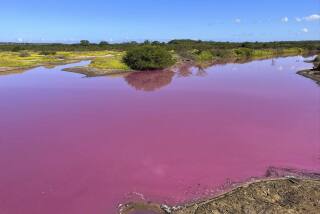Turning Pink Over Life in Bahamas
- Share via
NASSAU, Bahamas — A hot-pink hibiscus swayed from the visor of our bus as it turned uphill from the Nassau waterfront on our last day in the Bahamas. The driver, Reggie Saunders, suddenly stopped the vehicle--half on the narrow road, half off.
Oncoming traffic--one car and a moped--had to wait.
Reggie turned to the puzzled passengers and called out: “International Airport.” Then he walked toward a white cottage with a picket fence and a yard full of hollyhock and bougainvillea. He used a clothespin to attach a couple of sheets of paper to a line and, hand-over-hand, pulled them up to a second-story window.
“Just checking in with headquarters,” he said with a grin, as he started the bus once again.
Old Nassau is like that: good-natured, easygoing, comfortable.
Not far away, as a traffic light changed to red, Reggie called to a woman sitting by a basket in the shade of a poinciana tree.
“What you doin’?” he asked. “I say, what you sellin’?”
“Land crabs,” she said with a slow smile. “They’re big.”
“You save me some good ones,” Reggie said. “I’ll stop when I come back from the airport.”
As we rode on, he shared his recipe for land crab soup. All I remember is that it called for okra and tomatoes . . . and time. And that the woman’s straw basket had been decorated with rosy pink blossoms.
The Bahamian flag is aquamarine, gold and black, but the color I kept seeing was pink.
Pink stucco hotels stand near faded pink houses. Even the Nassau Public Library--formerly the prison--is pale pink stone with frayed green shutters. Georgian formality dressed in pastels, someone said. Someone was right.
There is the soft pink heart of the ubiquitous conch, which serves as the national shell as well as the national dish. Conch chowder is on every menu. A sculpted concrete conch adorns the Nassau airport. I ordered a tasty “conch burger”--it reminded me of abalone--at the Palm Cafe on Bay Street.
There is the bold pink of Androsian batik, the hand-crafted cloth of Andros, which is the largest Bahamian island. And the pink-fringed costumes of the carnival called Junkanoo. Even the pink coral of surrounding reefs becomes crushed, over time, into the blushing beaches of Eleuthera and other islands and cays.
Nassau claims 170,000 residents--two-thirds of the population of the Bahamas. The 700 islands beyond Grand Bahama and New Providence--the home of Nassau--are called the Family Islands. Only 28 are inhabited.
Old Nassau can seem quaint to visitors who see the low-rise wooden buildings and the surreys pulled by horses wearing straw hats stuck with posies.
But locals know better. Traffic on those narrow lanes has forced the installation of one-way signs. Cruise ships and gambling have brought crowds. Bay Street, the main waterfront drag, is scheduled to become a pedestrian mall this year.
Lynn Holowesko, a native, an attorney and a mother of six, was swift to tell me: “To know the Bahamas, you must get away from ‘the city,’ as we call New Providence.”
She grew up in Nassau before there were high-rise resorts or glittering casinos, but also before there were many ways to make a living. More than 70% of all Bahamians are now involved with the tourist industry.
No one is against survival by tourism, Holowesko insists, but she believes that there is room in the Bahamas for both the resort/casino traveler and the quiet-seeking traveler. The Bahamian National Trust--in which she is active--has lobbied for judicious placement of new resorts so that the Nassau oceanfront does not become a wall.
But the character of “the city” admittedly has been altered in recent years, and Nassau residents get dreamy over their favorite escapes among those Family Islands.
“The best is Harbour Island,” an airline agent said confidentially. “It’s only a 30-minute flight from Nassau to Eleuthera, and then a ferry boat ride. You should go there next time.”
Harbour Island is known for 3 miles of perfect pink beach--the whole east side of the island. And a barrier reef that holds back the ocean waves and makes the waters calm for swimming. Its winsome Dunmore Town, one of the oldest settlements in the New World, was founded in the 17th Century by English dissidents.
“It’s so tiny you can walk everywhere,” the airline man added. “No need for a car. If you get tired you can rent a golf cart.”
“I believe Andros is the best for diving and for bonefishing,” a Nassau policeman said as he kept one eye on the crowds pouring from cruise ships on Prince George dock. “I’m goin’ back soon.”
Yachtsmen extolled the winter regattas around Exuma’s Elizabeth Harbour. Others talked of exploring the caves on Long Island--so named because it is 3 miles wide and 64 miles long--or hiking on Cat Island, still a secret to most tourists. The island claims the highest point of any of the lily-pad-flat Bahamas: Mt. Alvernia at 206 feet.
A hotel waiter--and admitted bird fancier--sold me on the wild beauties of Great Inagua, far to the south, with its flock of 50,000 flamingos, the national bird.
“When they take off you won’t believe it, but the whole sky turns pink,” he said. “Real sweet pink.”
More to Read
Sign up for The Wild
We’ll help you find the best places to hike, bike and run, as well as the perfect silent spots for meditation and yoga.
You may occasionally receive promotional content from the Los Angeles Times.




